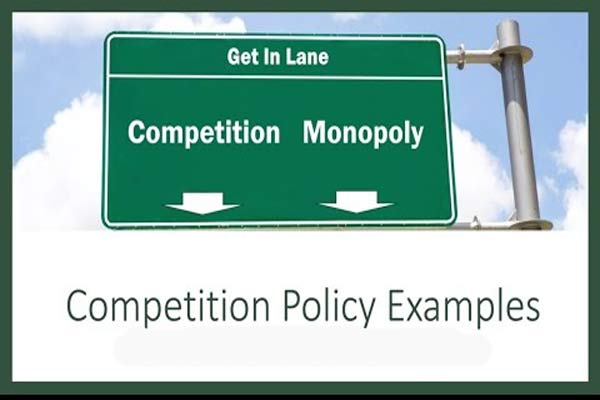
It is important to bear in mind that competition policy involves more than just enacting and implementing an anti-monopoly law. In fact, competition policy encompasses all government policies that promote competition among producers.
Competition policy can also be defined as encompassing all government policies that preserve and protect competition among independent buyer s and sellers in relatively unregulated markets.
An appropriate competition policy includes both (1 ) market – opening or competition-promoting policies that enhance competition in national and local market s (e.g . deregulation policies In general , including liberalization of trade and foreign investment policies , deregulation of previously regulated industries , and privatization of SOEs) ; and (2 ) a competition law (sometimes referred to as anti-trustor anti-monopoly law ) designed to prevent anti-completive business practices by firm s and , in the vie w of the author , unwarranted government intervention in the marketplace .
In the broad context of competition policy , an anti-monopoly law is one component of competition policy , but i t is the last resort , the method of enforcing competition when other policies have-not been successful or effective in making market s mor e competitive (Lloyd , 2000 : 1 ) . Thus , an anti-monopoly law can be an important source of support to competition policy by providing a framework for judging anti – competitive business practices by firms . However , in practice an anti – monopoly law is limited in its scope and should not be viewed as a substitute for on-going efforts ode regulate and liberalize an economy .
Similar to broader competition policy , the primary objectives of an anti-monopoly law ar eto maintain and encourage competition as a means to promote economic efficiency y and to maximize consumer welfare . To achieve this , the law should focus on the actual or potential business conduct of firm s in a given market , and not on the absolute or relative size of firm s or the structure of an industry . This requires competition authorities to assess whether a fir m (or group of firms ) exercises (exercise ) market power by engaging in business practices which substantially lessen s or prevent competition , rather than penalize large fir m size or industry concentration.
As the primary objective of an anti-monopoly law is to maintain and encourage competition , objectives lik e ‘control of economic power ‘ or ‘protection of small enterprises ‘ ar e generally viewed as inconsistent with market efficiency , and there fore not compatible with the primary objectives of such laws . This is important to hear in mind , as these laws are designed to protect the competitive process , and not competitors , whether small or large.
After the end of the oi l boo m in 1982 , the Indonesian government initiated several market-opening and competition-promoting policies to improve economic efficiency and stimulate the development of a mor e competitive private sector, including foreign investors , which could generate a greater stream of non-oi l exports to offset the steep decline in oil exports. These policies included fairly comprehensive and far – reaching deregulation measures , including successive trade reform store duce the ‘anti-trade bias ‘ of the trade regime, and an increasingly liberal foreign investment scheme to attract mor e foreign direct investment (FDI) , particularly in export-oriented projects .
While the steady deregulation of the trade regime did lead to increased impor t competition , and the liberalized foreign investment scheme led to the entry of ne w foreign investor s in several fields , including in field s formerly barred to fDI , domestic competition remained hobbled by various restriction s and onerous regulations . Without the Asian economic crisis and the subsequent fall of President Suharto in May 1998 , domestic competition might have become increasingly stifled by the proliferation of policy-generated barriers to domestic competition .
As a result of the agreement with the IM F (MEFP) , the Indonesian government under too k several measures to enhance competition , including the removal of trade and investment barriers , privatization of SOEs , and dismantling of sectoral monopolies (e.g . Bulog , the Food Logistic s Agency , which monopolized important foodstuffs , such as sugar and soybeans) . These measures went someway in reducing the market power of cartel s and conglomerates. However , as these measures were still inadequate to create mor e competitive markets , the introduction of an anti-monopoly law and its effective implementation and vigorous enforcement were considered critical to increasing competition .
Hal Hill, an Australian economist and keen observer of the Indonesian economy , has argued that an open trade regime would be by far the most effective (and administratively simple ) mean s of combating potential monopoly problems , since almost all agricultural and industrial activities are tradables . Even though much of Indonesia’ s mode m sector economy , including manufacturing , is characterized by quite high seller concentration ratios , these high ratio s are not necessarily a problem , if these industries are ‘contestable’ , that is i f barriers to import s and tone w domestic competitors are minimal.
In response to Hill’ s arguments , one could argue that the pro – competitive effect s of tarif f reduction s may be diluted if import supply is not very elastic . This happen s when increased demand for import s can only be met a t significantly higher prices , or when import s arerelahvely insensitive to changes in domestic prices. Moreover , trade policy consist s of more than just trade policy alone . The Indonesian government could als o use other tool stol mit import competition , including impor t quotas , voluntary export restraint s (VERs) , anti – dumping , and countervailing duties . While a true ‘free trade policy ‘ requies that all these import rest rich on be removed , in reality this never happens . Moreover , a significant share of economic activities consist s of non-tradable e good s and services , and is there for enot affected by impor t liberalization . Hence , aliberal trade regimel cannot effectively substitute f or an anti-monopoly law .






